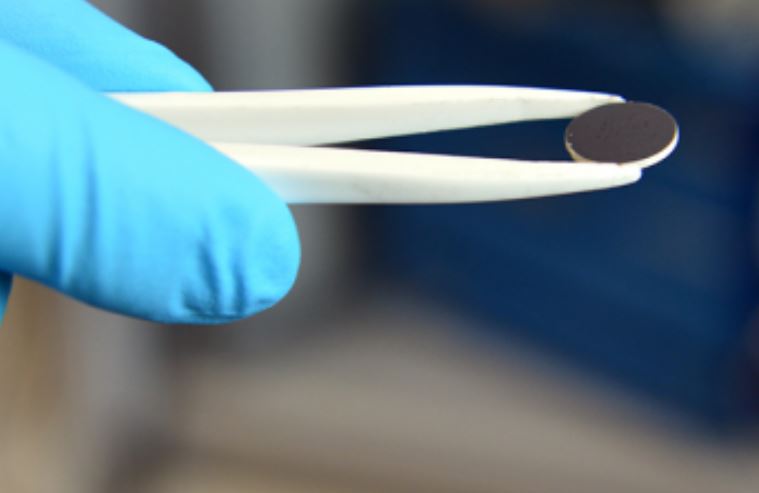Dry battery for more safety
Researchers at ETH Zurich have developed a lithium-ion battery that consists exclusively of solid material - it contains neither liquids nor gels. Even at very high temperatures, it cannot ignite.

Lithium-ion batteries can store a lot of energy in a small space. This makes them the energy source of choice for mobile electronic devices. Cell phones, laptops, e-bikes and electric cars are now powered by such batteries. Researchers at ETH Zurich have now developed a type of battery that, unlike conventional ones, consists exclusively of solid chemical compounds and is non-flammable.
Classic lithium-ion batteries are not entirely harmless: cell phone batteries have exploded several times in the past, causing injuries. And in the old town of Steckborn on Lake Constance, an entire row of houses burned down six months ago. The blaze was caused by a model battery that caught fire, presumably because it had been improperly charged.
Solid state batteries can be heated strongly
In classic lithium-ion batteries, as well as in most other batteries, the positive and negative poles - the two electrodes - are made of solid conductive compounds; charges move between these electrodes in a liquid or gel electrolyte. If you charge such a battery improperly (overcharge it) or leave it in the sun, the liquid can ignite or the gel can swell.
This is not the case with solid-state batteries, which are currently being developed in many research laboratories around the world: In them, not only the electrodes but also the electrolyte in between are made of solid material. "Solid electrolytes do not start to burn, even when they are heated very strongly or exposed to the air," explains Jennifer Rupp. She is a professor of electrochemical materials at ETH Zurich and led the development of the new type of battery.
Research at the interface
One of the challenges in developing solid-state batteries is to connect electrodes and electrolyte in such a way that charges can circulate between them with as little resistance as possible. ETH researchers have now found an improved manufacturing approach for this electrode-electrolyte interface.
In the laboratory, they produced a sandwich-type battery: A layer of a lithium-containing compound (lithium garnet) lies between the two electrodes as a solid electrolyte. Lithium garnet is one of the materials with the highest known conductivity for lithium ions.
"During fabrication, we made sure that the solid electrolyte layer had a porous surface," says Jan van den Broek, a master's student in Rupp's group and one of the study's first authors. On top of that, the researchers applied the minus pole material in liquid form; it was able to penetrate the pores. Finally, the scientists hardened the battery at 100 degrees Celsius. "With a liquid or gel electrolyte, you would not have been able to heat a battery to such high temperatures," van den Broek says. Thanks to the trick with the pores, the researchers were able to greatly increase the contact area between the negative pole and the electrolyte, which ultimately has the effect that the battery can be charged faster.
Higher temperatures for greater capacity
Batteries made in this way could theoretically be operated at normal ambient temperatures, says Semih Afyon, a former scientist in Rupp's group and now a professor at the Izmir Institute of Technology in Turkey. At the current stage of development, however, they don't really work well until about 95 degrees. "The lithium ions can then move better in the battery," Afyon says.
This circumstance could be used, for example, in battery storage power plants, which can store surplus energy and release it with a time delay. "Many industrial processes today generate waste heat that goes unused," Afyon says. "By coupling battery storage power plants with industrial plants, you could use the waste heat to run the storage power plant at optimal temperatures."
New thin-film batteries
"Many current solid-state battery research projects focus on improving electrolytes," Afyon says. He says there are few studies like this one, in which scientists assemble an entire solid-state battery - using the same methods used in industrial production - and test it.
"In this work, we have for the first time produced an entire lithium-ion battery with a solid lithium garnet electrolyte and a solid negative terminal made of an oxide. In this way, we have shown that it is possible to build entire batteries with lithium garnet," says ETH professor Rupp. Thanks to this solid electrolyte, it is not only possible to operate batteries at higher temperatures, but also to build thin-film batteries. These include batteries that can be placed directly on silicon chips.
"These thin-film batteries could revolutionize the way portable electronics are powered," Rupp says. In further research, she and her team are pursuing this approach. To that end, they also worked with industrial partners as well as the Paul Scherrer Institute and Empa. The immediate next steps will be to optimize the battery, in particular to further increase the conductivity at the electrode-electrolyte interface.
Text: Fabio Bergamin , ETH Zurich
Literature review: Van den Broek J, Afyon S, Rupp JLM: Interface-Engineered All-Solid-State Li-Ion Batteries Based on Garnet-Type Fast Li+ Conductors. Advanced Energy Materials 2016, 1600736, doi: 10.1002/aenm.201600736









